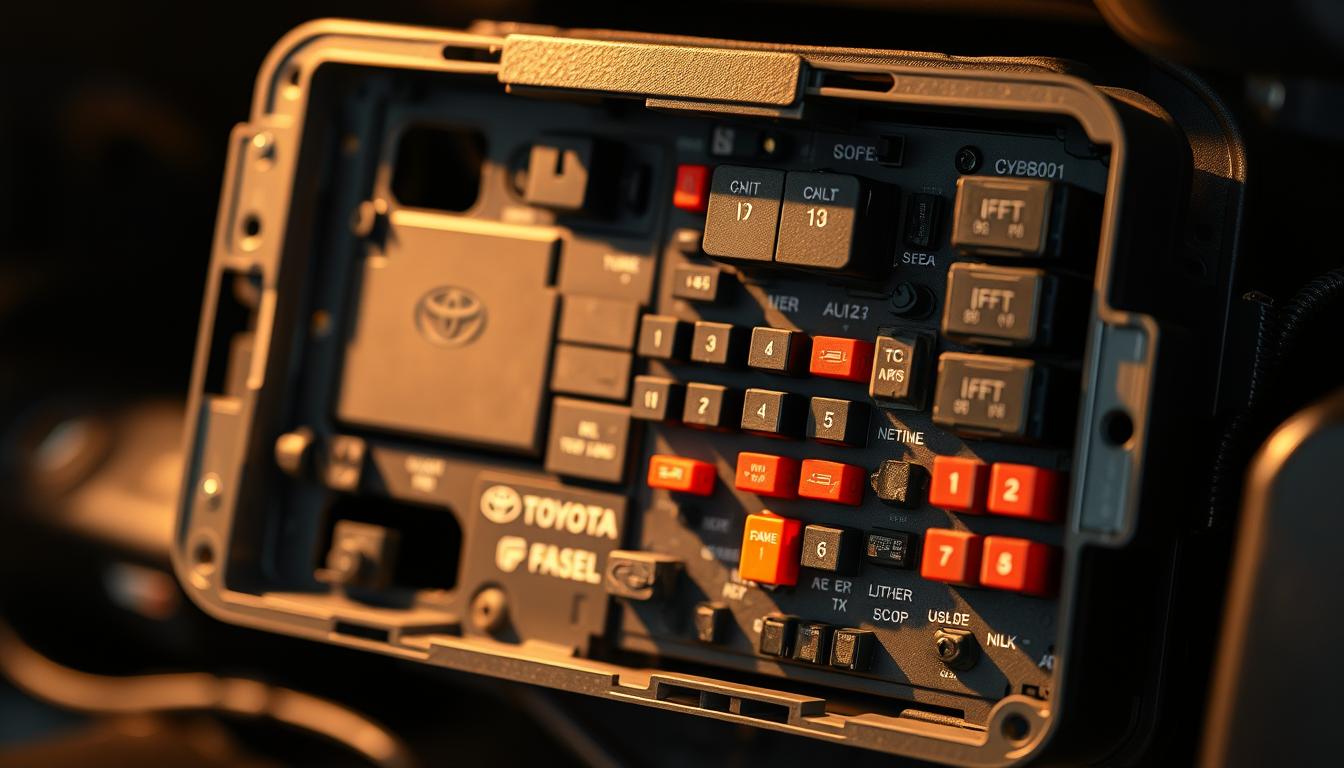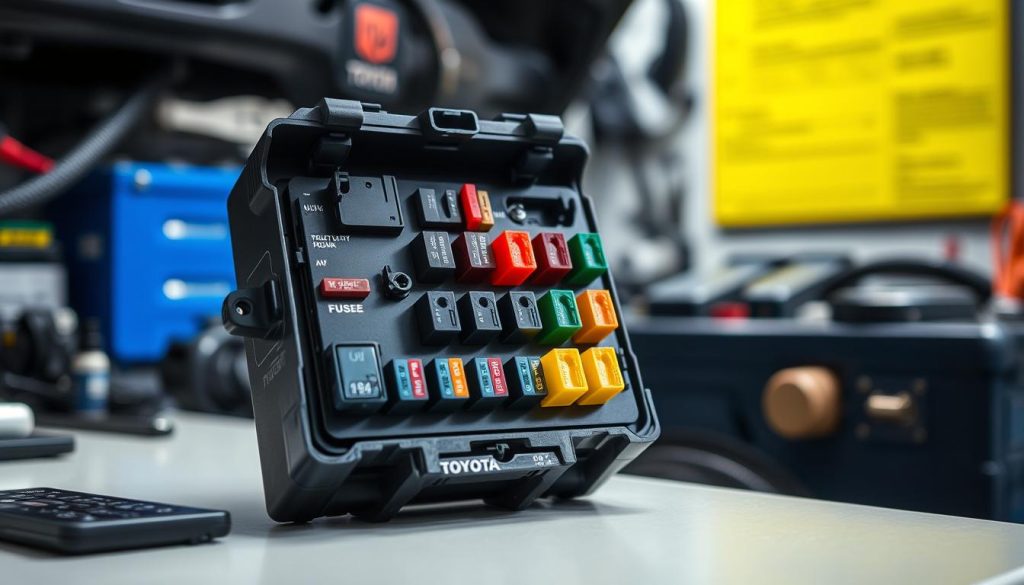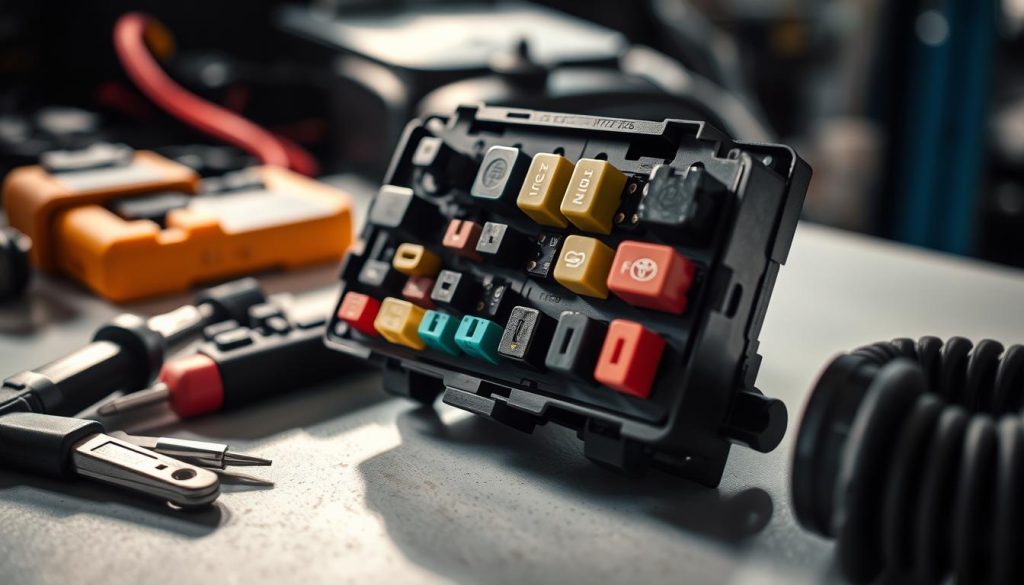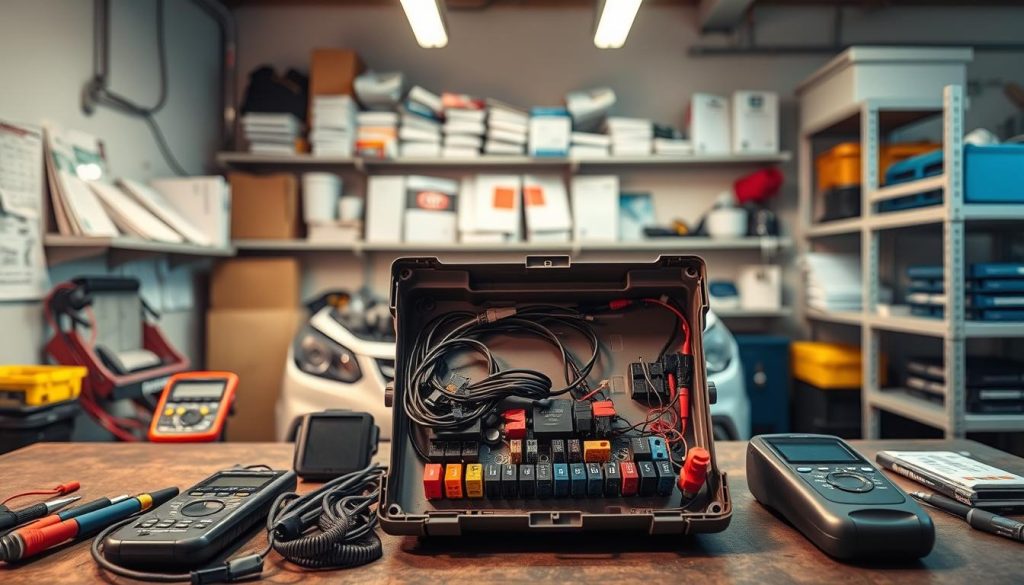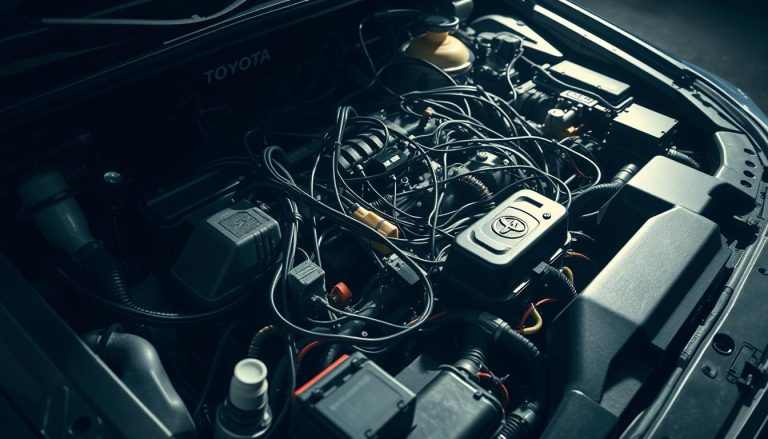Troubleshooting Toyota Fuse Box Problems & Fixes
It’s important to know how to fix Toyota fuse box issues to keep your car safe and reliable. The fuse box is key to your car’s electrical system. It stops circuits from getting too hot and keeps your car from getting damaged.
When the fuse box has problems, it can cause many electrical issues. This can affect your car’s lights, radio, and even the engine.
This guide will help you understand and solve Toyota fuse box troubleshooting. It will show you how to find and fix common Toyota fuse box problems. By using the tips in this article, you can make sure your Toyota’s electrical system works well for a long time.
Understanding the Toyota Fuse Box
If you own a Toyota, knowing how its fuse box works is key. It keeps your car’s electrical system running smoothly. By understanding the Toyota fuse box diagram and how to maintain it, you can make your car’s electrical parts last longer.
What is a Fuse Box?
The fuse box in your Toyota is very important. It holds fuses that protect different electrical circuits. If too much current flows, a fuse blows, stopping damage. Knowing your Toyota fuse box diagram helps you find and fix electrical problems fast.
Location of Fuse Box in Toyota Vehicles
In most Toyotas, the fuse box is either under the hood or inside the dashboard. These spots make it easy to get to for maintenance or to fix electrical issues.
The Role of Each Fuse in the Box
Every fuse in your Toyota’s fuse box has a job. They protect everything from headlights and radios to engine systems. By checking your Toyota fuse box diagram, you can see which fuse does what. Regular checks and maintenance keep your car running well and avoid sudden electrical failures.
Identifying Common Toyota Fuse Box Problems
Spotting problems in your Toyota’s fuse box early can stop bigger issues. By watching for signs and symptoms, you can fix it fast. This keeps your car running well.
Signs of Fuse Box Issues
There are several signs of common Toyota fuse box problems:
- Electrical parts, like headlights or interior lights, not working right
- Strange noises, like buzzing or clicking, from the fuse box area
- The smell of burnt plastic, showing overheated or melted fuses
- Visible damage or corrosion around the fuse box
Symptoms of Bad Fuses
Bad fuses in the fuse box show up in specific ways:
- Electrical systems, like power windows or door locks, not working
- Constantly blown fuses needing to be replaced over and over
- Car won’t start or electrical system shuts down suddenly
- Dashboard warning lights turn on without clear reasons
Tools Required for Toyota Fuse Box Troubleshooting
For Toyota fuse box troubleshooting, having the right tools is key. Whether you’re a DIY pro or a beginner, the right tools help you fix electrical issues in your Toyota. They make diagnosing and repairing easier.
Basic Tools
To start troubleshooting, you’ll need basic tools most car owners have. These include:
- Screwdrivers (both flathead and Phillips)
- Pliers (needle nose and regular)
- Socket and ratchet set
- Wire cutters and strippers
- Flashlight or work light
Specialized Equipment
For better troubleshooting, you’ll need some specialized tools. These tools can really help:
- Multimeter – Essential for measuring voltage, current, and resistance. This tool helps identify which fuses are functioning correctly.
- Fuse Puller – A handy tool designed to safely remove fuses without damaging them or the fuse box.
- Test Light – Used to quickly check the presence of voltage in the fuse box circuit.
- OBD-II Scanner – Useful for diagnosing more complex electrical issues by reading error codes from the vehicle’s computer system.
- Electrical Tape – Essential for securing and insulating wires after repairs.
Step-by-Step Guide for Toyota Fuse Box Troubleshooting
Fixing Toyota fuse box problems needs a careful plan. This ensures safety and correct fixes. Follow these steps to find and fix common issues.
Initial Inspection
First, check the fuse box visually. Look for damage like melted covers, burnt spots, or corrosion. These signs mean there’s a problem that needs fixing right away.
Testing Fuses with a Multimeter
For accurate fixes, use a multimeter on each fuse. Here’s how:
- Take out the fuse from the box.
- Put the multimeter leads on both fuse ends.
- If it beeps or shows continuity, the fuse is fine. If not, it’s blown and must be replaced.
Replacing Blown Fuses
To replace a faulty fuse, follow these steps:
- Make sure the car is off to avoid electrical problems.
- Take out the blown fuse and put in a new one with the same amperage.
- Make sure the new fuse fits well in its slot.
Replacing the fuse right will fix the problem and stop more issues. Always have spare fuses ready for quick repairs.
Reading a Toyota Fuse Box Diagram
Learning to read a Toyota fuse box diagram is key for Toyota fuse box troubleshooting. Each diagram is a visual guide that shows all fuses and their roles. It helps you quickly find which fuse is for which circuit, making it easier to fix electrical problems.
A Toyota fuse box diagram is usually found on the fuse box cover or in the vehicle manual. It uses symbols or abbreviations to show what each fuse does. For example, ‘HEAD’ means headlight circuit, and ‘RAD’ means radio circuit. Knowing these symbols is essential for quick Toyota fuse box troubleshooting.
Here’s a simple table showing a generic Toyota fuse box diagram layout:
| Fuse Position | Label | Function |
|---|---|---|
| 1 | HEAD | Headlights |
| 2 | RAD | Radio |
| 3 | DEF | Defroster |
| 4 | IGN | Ignition System |
| 5 | AC | Air Conditioning |
Looking at the fuse box diagram before tackling electrical issues can save a lot of time. It ensures you check or replace the right fuse, avoiding mistakes and keeping your vehicle running smoothly. The diagram is like a map, guiding you through different circuits and their fuses, making troubleshooting faster.
Common Toyota Electrical Problems Linked to the Fuse Box
Toyota owners often face electrical issues linked to the fuse box. Knowing the signs of these problems can help fix them quickly. This ensures your vehicle runs smoothly.
Malfunctioning Starters
One common problem is a malfunctioning starter. If the starter doesn’t get enough power, it might not work right. Regular checks of the fuse box can help avoid this.
Dead or Weak Batteries
Dead or weak batteries can also be a sign of fuse box issues. Faulty fuses can stop the battery from charging properly. Keeping an eye on fuse health can help prevent this.
Faulty Alternators
Another issue is a faulty alternator. Sometimes, problems with the alternator are caused by bad fuses. Checking the fuses for the alternator can help keep the electrical system working well.
Keeping the fuse box in good shape is key to your vehicle’s electrical health. Regular checks and replacing faulty fuses can make driving more reliable and enjoyable.
How to Prevent Toyota Fuse Box Problems
Keeping your Toyota running well means taking care of the fuse box. Fixing fuse box issues early can save you money and time. Here are some tips to keep your fuse box in top shape.
Regular Maintenance Tips
It’s important to check your Toyota fuse box often. Here’s how to do it right:
- Look for any wear or damage on the fuse box cover.
- Check all connections for corrosion or loose parts.
- Swap out old or brittle fuses, even if they haven’t blown yet.
- Make sure fuse ratings match your vehicle’s needs to avoid circuit overload.
Signs to Watch For
Spotting early signs of fuse box problems can stop bigger issues. Watch for these signs:
- Intermittent electrical failures, like flickering lights or broken accessories.
- Strange noises from the fuse box, like buzzing or clicking.
- A burning smell, which could mean overheating or an electrical fire risk.
- Visible damage or melting on the fuse box or fuses.
Expert Tips for Fixing Toyota Fuse Box Issues
Fixing a Toyota fuse box needs careful steps for a good fix. Knowing what went wrong is key. Here are some tips from pros to help you tackle tough problems.
- Thorough Diagnosis: Start with a detailed check. Use a multimeter to find voltage problems and make sure connections are tight.
- Proper Tools: Have the right tools ready, like pliers, screwdrivers, and fuse pullers. These are vital for fixing the fuse box right.
- Quality Replacements: Choose high-quality fuses that fit Toyota’s standards. Low-quality or wrong fuses can make things worse.
- Routine Maintenance: Check the fuse box often for wear. Clean it and make sure wires are good to avoid future problems.
If you face complex issues that need special skills, get help from a pro mechanic. They can fix it right and save you time.
Replacing a Toyota Fuse Box: When and How
Replacing a Toyota fuse box is sometimes needed to keep your car’s electrical systems working right. Doing it on time can avoid dangers and expensive fixes. Knowing when to replace it and whether to do it yourself or get a pro is key for fixing Toyota fuse box issues.
Indications for Replacement
Knowing when to replace a Toyota fuse box can prevent car troubles. Here are some signs to watch for:
- Frequent blowing of fuses
- Corroded or damaged fuse box terminals
- Unresponsive electrical parts even with good fuses
- Visible burn marks or melted plastic around the fuse box
DIY vs Professional Replacement
Choosing between DIY and professional help for replacing a Toyota fuse box depends on your skills and the problem’s complexity.
- DIY Replacement: It’s cheaper but needs knowledge of car electronics. Make sure you have the right tools and follow a detailed guide.
- Professional Replacement: It’s pricier but safer and more precise. A mechanic can find and fix any hidden problems and install the fuse box right.
Thinking about the advantages and disadvantages of each option will help you make a smart choice. This ensures your car stays reliable and safe.
Toyota Fuse Box Maintenance for Longevity
To keep your Toyota’s fuse box working well, you need to maintain it regularly. Check and care for the fuse box often. This helps avoid electrical problems and makes it last longer.
Always clean the fuse box to keep it free from dirt and moisture. Dirt and moisture can cause corrosion, leading to electrical issues. Make sure the fuse box cover is tight to protect what’s inside.
It’s also important to check the fuses for wear or damage. Replace any blown or faulty fuses right away. This stops overloads that could harm the electrical system. Keep a spare set of fuses in your car for quick fixes.
Watch out for overheating or burning smells, which could mean a bigger problem. If you see these signs, get a mechanic to check it out. This way, you can fix the issue before it gets worse.
In short, following these maintenance tips helps your Toyota fuse box last longer. It also makes your car’s electrical system more reliable. Being proactive and careful can save you from expensive repairs and keep your Toyota running well for years.
Understanding the Toyota Fuse Box Fuse Chart
Dealing with electrical issues in your Toyota? A key tool is the Toyota fuse box fuse chart. It helps you find out what each fuse does. This makes fixing problems easier and faster.
The chart is usually inside the fuse box cover or in your owner’s manual. It shows all fuses and what they protect. Knowing this chart helps you find the fuse causing a problem.
| Fuse Position | Amperage | Protected Component |
|---|---|---|
| 1 | 10A | Horn |
| 2 | 15A | Headlights |
| 3 | 20A | Radio |
| 4 | 30A | AC System |
Using the Toyota fuse box diagram with the chart makes things easier. Together, they help you find and fix blown fuses fast. This gets your car’s parts working right again.
In short, knowing the Toyota fuse box fuse chart and diagram helps you keep your car’s electrical system in top shape. It makes fixing problems simple and quick.
Troubleshooting Advanced Fuse Box Issues
Dealing with complex *Toyota* fuse box problems requires a deep understanding. You need to know how to diagnose and fix wiring issues and full electrical system failures. This involves diving into the heart of your vehicle’s electrical system.
Diagnosing Wiring Problems
Advanced Toyota fuse box troubleshooting means finding faulty wiring. This can be tough. Start by looking for wear, corrosion, or damage on the wires connected to the fuse box. Use a multimeter to check if electrical current flows right through each wire.
Modern Toyotas come with detailed wiring diagrams. These help trace wiring problems. Check your vehicle’s manual or ask a certified Toyota technician to help you understand the wiring diagram. This will help you find where electrical flow might be blocked.
Addressing Electrical System Failures
Toyota electrical system failures can be linked to fuse box problems or the vehicle’s electrical network. Begin by checking the fuse box for blown fuses or loose connections. Then, check the battery and alternator, as problems here can affect electrical flow.
Advanced troubleshooting might need special tools, like an oscilloscope, to check electrical signals. Fix any problems by replacing faulty parts and making sure all connections are tight and corrosion-free.
Effective troubleshooting of Advanced Toyota fuse box issues and electrical system failures ensures your vehicle runs well. This reduces future breakdowns and improves your driving experience. With the right tools and approach, even complex electrical problems can be fixed, keeping your vehicle running smoothly for years.
When to Consult a Professional Mechanic
Electrical problems in your Toyota are serious. While small issues might be fixed at home, some cases need a mechanic. Knowing when to seek help keeps your car safe and running well.
Signs you need a mechanic for your Toyota fuse box include frequent electrical failures. If fuses keep blowing or your car’s electrical system acts strangely, it’s a sign of a bigger problem.
Also, if your car’s lights flicker or power goes off and on, get a mechanic’s help. These issues might mean there’s a serious problem or wiring issue that needs a pro to fix.
Seeing burning smells or damage near the fuse box means you need a pro. Trying to fix big electrical problems yourself can cause more harm and be dangerous.
Getting a mechanic to fix your Toyota fuse box ensures all problems are solved right. They know how to find and fix issues quickly, saving you time and money.
| Scenarios | Action |
|---|---|
| Recurring electrical failures | Consult a mechanic |
| Erratic electrical behavior | Consult a mechanic |
| Burning smells or visible damage | Professional Toyota fuse box repair |
Best Practices for Toyota Electrical System Health
Keeping your Toyota’s electrical system in top shape is key for its performance and life span. By following these best practices, you can keep your vehicle running smoothly.
- Regular Inspections: Check the electrical parts like fuses, wires, and connections often. This helps spot any problems early on.
- Clean Battery Terminals: Make sure your battery terminals are clean and free from corrosion. This ensures your vehicle’s electrical system works well.
- Check Charging System: Test your vehicle’s alternator regularly. A bad alternator can cause many electrical problems.
Following these best practices will help you avoid common electrical issues. It also helps extend the life of your vehicle’s parts. Plus, it prevents expensive repairs and keeps your car running reliably.
- Utilize Original Equipment Manufacturer (OEM) Parts: Always choose OEM parts for replacements. They are made to fit your Toyota perfectly, ensuring better performance.
- Mind the Load: Don’t overload your electrical system with too many accessories. This can put a strain on your system and cause failures.
- Keep Software Updated: Keep your vehicle’s software current. Updates can fix issues and improve your electrical system’s performance.
By making these practices a part of your routine, you can greatly improve your Toyota’s electrical system health. These tips are useful for both new and experienced car owners, helping you keep your vehicle in top condition.
Latest Trends and Innovations in Vehicle Fuse Box Technology
Recent changes in fuse box tech have greatly impacted modern cars, including Toyotas. Smart fuse technologies are now common. They watch electrical loads in real time and give diagnostic info for better safety and efficiency. They also cut off power if they find a problem, to avoid damage.
Miniaturized fuse boxes are also gaining traction. They are smaller and lighter, fitting in tight spots in cars. This saves space and makes the car look better and work better.
Solid-state fuses are another big step forward. They’re faster and more reliable than old thermal fuses. They can handle more current and cut down on electrical overloads, keeping the car running smoothly.
There’s also a push for better connectivity in fuse boxes. New fuse boxes work well with car diagnostic systems. This makes it easier to check and fix issues, keeping owners informed and worry-free.
Using eco-friendly materials is another trend. Car makers are using recyclable and green parts. This helps the planet and shows they care about the environment.
In short, new fuse box tech is changing how we see cars, including Toyotas. Keeping up with these changes means your car stays modern and reliable.
Conclusion
In this guide, we covered a lot about fixing and keeping your Toyota fuse box in check. We talked about what it’s made of, common problems, and how to prevent them. A well-kept fuse box keeps your car running smoothly and avoids expensive repairs.
Learning the basics of checking and replacing fuses helps a lot. It lets you fix small issues before they get big. The guide also stressed the need for regular checks and watching for warning signs.
By using the tips from experts, you can make your Toyota’s electrical system last longer. It will stay reliable and efficient. This guide aims to give you the tools to manage your car’s fuse box well. Remember, taking care of your fuse box early can save you a lot of trouble.
FAQ
What is a Fuse Box?
A fuse box is a key part of a Toyota’s electrical system. It holds fuses that protect different electrical circuits. This prevents overloading or short-circuiting.
Where is the Fuse Box located in Toyota vehicles?
The fuse box’s location varies by Toyota model. It’s often found under the dashboard, in the engine compartment, or in the trunk.
What are the signs of a bad fuse in a Toyota?
Bad fuse signs include non-working electrical parts, odd sounds or smells, and visibly damaged fuses.
What basic tools are needed for diagnosing fuse box issues?
You’ll need a set of screwdrivers, a fuse puller, and a digital multimeter for testing fuses.
What specialized equipment can help with Toyota fuse box troubleshooting?
For advanced troubleshooting, you might need an advanced multimeter, a circuit tester, and fuse testers made for cars.
How do I test a fuse using a multimeter?
Set the multimeter to continuity. Place probes on the fuse ends. A good fuse shows continuity; a blown one doesn’t.
What common electrical problems can be linked to the fuse box?
Common problems include faulty starters, dead or weak batteries, and bad alternators. These can all stem from a fuse box issue.
How can I prevent fuse box issues in my Toyota?
Regularly check fuse condition and clean the fuse box to avoid corrosion. Replace damaged fuses quickly to stop electrical problems.
When should I consider replacing my Toyota fuse box?
If you face frequent fuse problems or electrical failures that simple fixes can’t solve, it’s time to replace the fuse box.
Should I replace the fuse box myself or consult a professional?
For simple tasks, a skilled car owner can replace the fuse box. But for complex issues or if you’re not sure, a professional mechanic is best.

